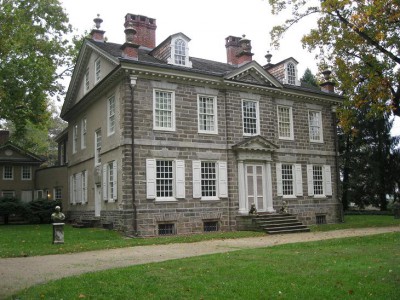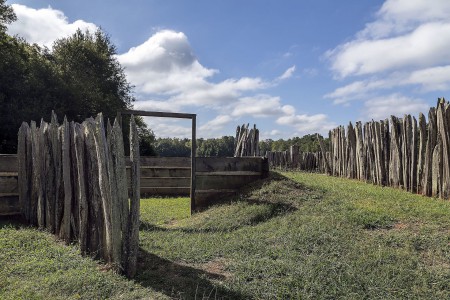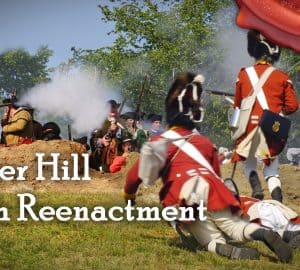Visiting a battlefield can give you a far richer experience than just reading what happened there. It gives a greater depth to the story, and you can strive to visualize what the hills, fields and woods looked like when covered with armed men. Over the years, the Discerning History team has had the opportunity to visit many of battlefields from the American War for Independence. Here’s our picks for the best Revolutionary War battlefields to visit. We have chosen them based on the beauty of the location, how much they enhance your understanding of the battle, how well the landscape has been preserved and how important the original event was.

10. Germantown
After the British army under William Howe captured Philadelphia in 1777, George Washington mounted an attack on a British outpost at Germantown. After hours of fierce fighting, his army eventually retreated from the field. Although there is no park or museum commemorating the battle, several buildings from the time still stand. Most interesting is the Chew House, a strong stone building in which a group of regulars took shelter and beat back attacks from the Continental forces for several hours.

9. Guilford Court House
In the Battle of Guilford Court House, under 2,000 British solders under Lord Cornwallis defeated an American army under Nathanael Greene over twice their size. The British quickly pushed through three Americans lines, and won the battle in only ninety minutes. But they suffered very heavy casualties along the way, with about 25% killed, wounded or captured. The wooded battlefield is preserved today by the National Park Service. There is a road which you can drive or walk to take a tour of the site. You will find commemorative monuments and markers explaining the story of the battle.

8. Princeton
Washington’s surprise victory at Trenton is one of the classic stories of the American Revolution, but the battle of Princeton is less well known. Just days later, the Continentals attacked the British garrison at Princeton. The battle was hard fought, at one point the patriot militia began to falter, and Washington himself rallied them. But at length the British collapsed, and the day was won. The battlefield is better preserved than many from this war. It is commemorated by several monuments, and a state park contains some important sites including the Clarke House, which was standing at the time of the battle. Also of interest is Nassau Hall at Princeton University, at which Alexander Hamilton fired American cannon to drive out some British who had taken refuge inside.

7. Fort Ninety Six
The small village of Ninety Six was an important Loyalist stronghold in South Carolina. In 1780 the British built a palisade and several redoubts to defend the place. The next year it was besieged by the American army under Nathanael Greene. For nearly a month he tried to capture it from the smaller force of loyalists. The Patriots successfully stormed one redoubt and fought fiercely for the large Star Redoubt, but they were eventually driven off by hand to hand fighting. Greene quickly retreated, as a relieving British force was close at hand. Today the National Park Services maintains the old site of the town of Ninety Six, as well as the earthworks and a reconstructed stockade.

6. Cowpens
Daniel Morgan’s stunning victory at Cowpens, South Carolina, was a critical battle for the American cause. Morgan handled his mix of militia and Continentals ably in what was arguably the war’s greatest tactics. When they fell back, the British were convinced that the battle was won, leaving them unprepared for a double envelopment from the Patriots. More than a thousand British were casualties, compared with about 150 Americans. Today the battlefield is preserved by the National Park Service. Walk the battlefield trail to see the positions of the troops, and get a sense of the scale of the fighting.
5. King’s Mountain
King’s Mountain, in north-central South Carolina, was a crucial victory for the Americans in the southern theater. The loyalists under Patrick Ferguson were defeated by a force of patriots, many of them “over mountain men” who came from the settlements on the other side of the Applacian Mountains. It is easy to get a sense of the fighting today, as you walk around the top of the mountain where the loyalists made their stand, and imagine the patriots charging up the steep sides, studded with rocks and trees.

4. Fort Ticonderoga
Fort Ticonderoga is the best and most important fort surviving from the American Revolution. It was built by the French during the French and Indian War, and saw two battles during that war. Its dramatic capture by Ethan Allen and the Green Mountain Boys was one of the patriots’ early successes. The fort later fell into British hands, and they defended it against an American attack in 1777. Ticonderoga was restored in 1909. Today it is an excellent site to visit, and costumed guides do cannon firing demonstrations.

3. Lexington and Concord
It was the “Shot Heard Round the World” on the green in Lexington, Massachusetts that began the American Revolution. The victory at Concord later that day was pivotal to the American cause, as it showed that the colonial militia could defeat the regulars. Lexington is a great place to visit today, and while walking around across the green and through the period houses and taverns around it you can really get a sense of how the fighting progressed. The landscape along “Battle Road,” from Lexington to Concord, looks much like it did in 1775. Also interesting is the reconstructed North Bridge at Concord. Walk down from the Visitor’s Center to retrace the steps of the Patriots who gave the first check to the British forces.

2. Yorktown
The capture of the British army under Lord Cornwallis at the siege of Yorktown, Virginia, was the crowning victory of the Revolution. While the war went on for several more years, the fighting in America was effectively won. It is also one of the most interesting battlefields to visit. Many of the fortifications that were built during the siege have been reconstructed, and they have palisades and cannon to boot. Make sure to see Redoubts No. 9 and 10, which were stormed by the American and French troops near the end of the siege. You can also go into the village, where there is a battle monument and several historical homes run by the National Park Service.

1. Saratoga
Although Saratoga, in upstate New York, is one of the more remote of the battlefields of the American Revolution, it is unarguably one of the most picturesque. Standing on the bluffs next to cannons marking the artillery positions, you can look across the beautiful fields and woods down to the Hudson River. Victory in the Saratoga campaign was crucial to the American cause, as Horatio Gates’s capture of John Burgyone’s British army helped convince France to enter the war on the American side. Although virtually none of the earthworks have survived, colored stakes mark the positions of the armies. Of special note are the many artillery positions, the Neilson House which Benedict Arnold used as his headquarters, and the site redoubts which the Americans attacked during one of the battles.

Bonus: Downtown Boston
Boston, Massachusetts was arguably the most important city in America for the revolutionary cause. It was one of the main places that stood up against the authority of the British Parliament. The town itself was besieged by the Patriot forces in 1775-1776, in the longest siege ever to take place in the United States. Although the terrain has changed considerably and the sites of the battles around the town have fallen to development, you can still see many historic locations. These include monuments commemorating the battles of Bunker Hill and Dorchester Heights, the Old State House, in front of which is the site of the Boston Massacre out in front, the Old South Meeting House where the Boston Tea Party was planned, the Old North Church, Paul Revere’s House, and many more.
If you liked this post, you may also enjoy our Top 10 Best Civil War Battlefields. What Revolutionary War sites have you visited? Which was your favorite? Comment below and let us know!





Thanks! I will be sure to visit some of these ‘top 10’ sites on our east coast road trip this summer. I just read Revolutionary Summer and am working on Washington’s Secret Six for further inspiration.
David A. from Dickinson TX
Brandywine deserves to be in the list, before Germantown. Paoli as well, imho. Germantown was a ferocious battle and the Chew House is a monument to this great conflict. But Brandywine was a turning point in the war. The first time the Continentals stood toe to toe with the British Army and while they won the field, Thomas Paine correctly observes the next day in the American Crisi that the beating taken by the British would eventually lead to their defeat. Brandywine is also tye largest single day battle of tye war. Howe resigned a month later.
I think Monmouth Battlefield should be easily on this list. This is one of the best preserved revolutionary war Battlefields. You can still see what it was like 240 years ago. This is where the Continentals had their first battle after being trained by Steuben.
It’s Guilford, not Gilford.
Thanks for catching that!
Great article, though I agree there are other battlefields that could be included. And, not to put too fine an edge on it, the Boston Massacre did not take place where the marker is, but rather farther down State Street.
Fort Griswold in Groton CT should be on this list. The fort is incredibly well preserved and is the site of the Battle of Groton Heights when British troops led by Benedict Arnold ultimate took the foot and then slaughtered the American defenders.